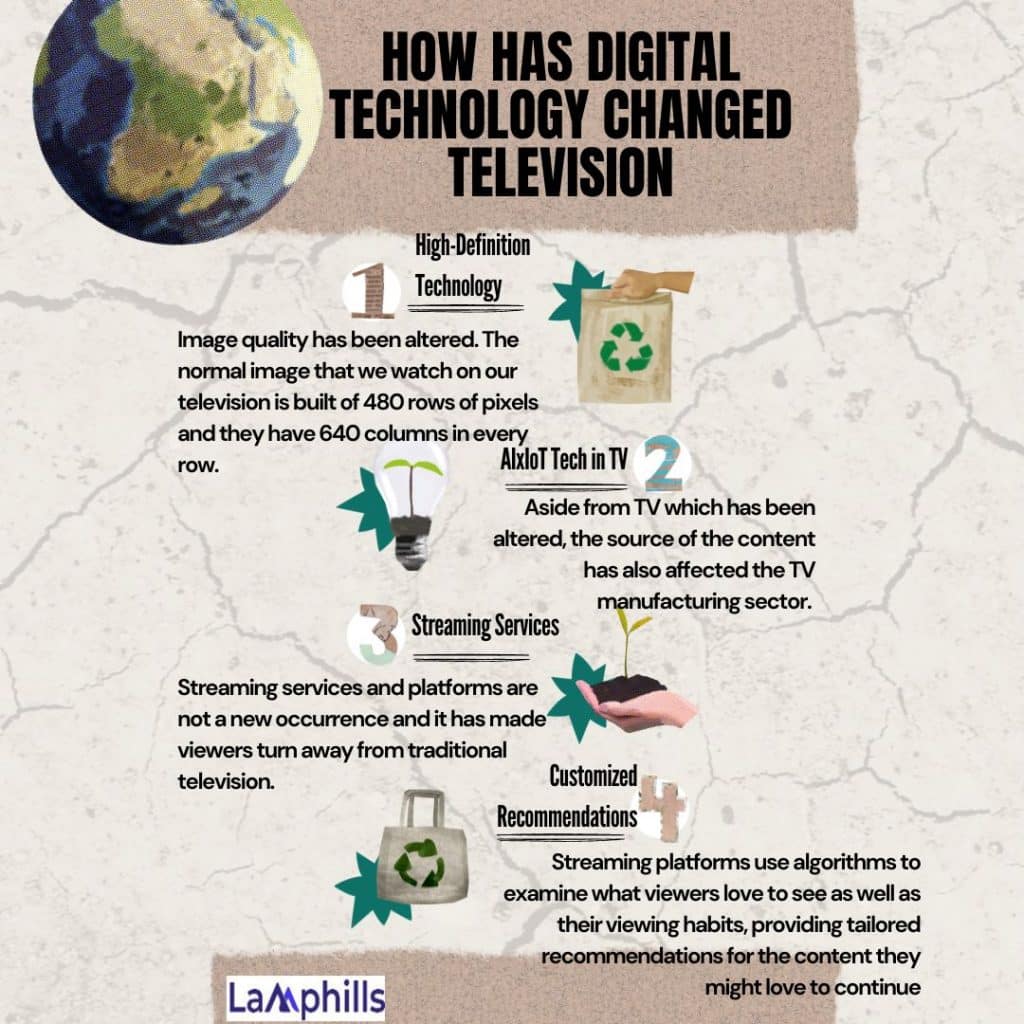Innovation has had a big impact on how we watch TV, changing everything from the content we watch to how and where we watch it. Outlined below are some of the key ways in which digital technology has changed television. In this digitally advanced era, one outstanding change can be noticed in how we use our television. It’s only normal that you wonder how digital technology has changed how we use our television. This article will explore how digital technology has changed television. These are some notable changes I have noticed, and I would love to tell you about them.
Key Points
- In the past, cable and satellite TV used to be highly sought after. However, these providers have now been surpassed by new channels offering different types of content.
- Streaming services and platforms are not a new occurrence, and they have made viewers turn away from traditional television.
- Television as we know it now is no longer the traditional television we once knew, it has become more interactive with the integration of social media, etc.
- The advancements in production technology, such as computer-generated imagery and virtual reality (VR), have revolutionized the creation and consumption of content.
This checklist will assist you in recognizing the significant impact that digital technology has had on television. Click on the Download button to download.
I hope you found the preceding information helpful. Next, we’ll examine how technological advancements impacted television.
How Did Technology Change Television?
Allow me now to highlight some of the ways digital technology has changed television, let’s dive right in.
#1. High-Definition Technology
Image quality has been altered. The normal image that we watch on our television is built of 480 rows of pixels and they have 640 columns in every row.
However, improving the number of pixels can greatly enhance the level of resolution. Thanks to this, we have the opportunity to enjoy HDR images on our TVs due to the transformation to digital technology.
In recent times, pretty much all television from famous brands like TCL is HD ready, this implies that the best smart televisions will provide a resolution of 720p.
#2. Smart TV
When we use the term ‘smart ‘ in relation to televisions we simply mean any television that is connected to the internet and at the time of writing this piece, TCL happens to be the second largest producer of the best smart TVs in the world.
The TCL Smart TVs are equipped with built-in apps that enable users to download specific apps that they wish to use.
If you wish to get the best out of your smart TV, the best TCL TVs come with the latest Android version that permits the users of the TCL Smart Android TV to effortlessly download their favorite applications.
#4. AIxIoT Tech in TV
Aside from TV which has been altered, the source of the content has also affected the TV manufacturing sector.
Before now, cable and satellite TV was what people yearned for but now the cable and satellite TV providers have been left behind and people have found new types of content on channels that were not available for consumption several years back.
Even though TV is still mainly considered to be an entertainment device, there are several things you can do with your television aside from keeping you engaged.
Thankfully artificial intelligence and the Internet of Things allow TCL TVs to become your home’s hub.
You can now effortlessly connect and use all your smart devices from your TCL TV. If you choose to do this, it can easily reduce your stress and save you so much time.
#5. Mini LED
One thing you should always expect is change because change is a very constant thing and our televisions also experience these changes. Just as technology improved TV commissions experienced huge improvement.
For years, TV manufacturers like TCL have tried to improve their customers’ viewing experiences. The company recently launched the latest TV technology which is referred to as the Mini LED.
This television is capable of producing an impressive effect through several mini LEDs embedded in the TV panel.
The television produces light depending on the current it collects making it able to provide excellent picture quality. Hurry now and go get yours to enjoy a beautiful viewing experience.
What Is the Impact of Technology on Television?
Technology has played a very big role in shaping how we use our television and the television industry at large. This new feature has provided viewers with more options, interactivity, and amazing experiences than ever before.
#1. Image Quality
We now have several image qualities such as High-definition (HD) and Ultra High Definition (UHD) technologies. These improved image quality have changed the viewing experience, providing superb, clear pictures with rich colors and improved detail. This amazing improved feature has made the television seem more entertaining and captivating.
#2. Streaming Services
Of course, streaming services and platforms are not a new occurrence and it has made viewers turn away from traditional television. Some of these streaming platforms and services include Netflix, Hulu, and Amazon Prime Video.
These streaming platforms provide on-demand access to a lot of streaming options and content, this enables viewers to choose whatever they wish to watch whenever they want without the usual restriction of a broadcast schedule.
#3. Smart TVs and Internet Connectivity
This type of television is now the other of the day as almost everyone owns a smart television and it comes with built-in internet connectivity and the ability to run apps.
This feature allows users to access streaming platforms, browse the web, and access social media platforms literally from their television screens.
#4. Interactive Features
Television as we know is no longer the traditional television we know, it has become more interactive with the integration of social media, permitting viewers to watch shows on streaming platforms, they can also engage in social media conversations through hashtags, polls, and live chats.
#5. Customized Recommendations
Streaming platforms use algorithms to examine what viewers love to see as well as their viewing habits, providing tailored recommendations for the content they might love to continue. This enables viewers to find new shows and movies that align with their tastes.
#6. Production Technology
Developments in production technology, some of which include computer-generated imagery as well as virtual reality (VR), have changed the way content is generated and consumed.
These tools help filmmakers to develop extraordinary visual effects and captivating storytelling experiences.
#7. Accessibility
Technology has made television more available to a broader audience, such as those with disabilities.
Secure captioning, audio descriptions, and assistive technologies enable users with hearing or visual disabilities to enjoy television content.

What Are the Advantages of Digital Technology in Television?
So at this junction, I will be highlighting some of the advantages of digital technology in television.
#1. Improved image quality
Thanks to improvements in digital technology the transmission of images with higher quality for dramatically better picture and sound quality is now available (HDTV).
Several users will see better clarity and color when watching their favorite shows, sports, or entertainment programming.
#2. Digital Audio
Technology has brought about great improvement in digital audio and several digital TV broadcasts allow users to listen in single-channel (mono), stereo, or also surround-sound audio modes just like the Dolby Digital 5.1.
The latter also known as DD 5.1 needs four speakers for surround sound effects, a center speaker for dialogue, as well as a subwoofer for bass effects.
This feature makes provision for the mono audio track to be published in multiple languages, but that feature is not globally used at present.
#3. Multicasting
DTV also enables the showing of many TV programs at once “multicasting.” Multicasting just as a DVD can include several programs on a single disc, so a DTV broadcast can comprise several TV programs on the very channel.
Multicasting enables the broadcaster to perform several audiences at the same time. A cable system operator can utilize channel space more smoothly by maintaining several digital cable programs on one channel.
#4. Datacasting
The broadcaster sends out data individually from any TV projects. That data could be anything ranging from prices and delivery details on a home shopping platform to interactive content and graphics on an educational platform.

#5. Reception problems are resolved
Digital technology has helped rectify reception issues such as ghosting, which disrupts most analog users in built-up or mountainous environments and becomes obsolete for digital viewers because the digital signal is transmitted more effectively than analog communications.
How Has Technology Changed the Media?
Technology has greatly altered the media sector, changing how information is generated, disseminated, and consumed. Outlined below are some of the major ways technology has impacted the media:
#1. Digital Transformation
There has been a noticeable change from print to digital media and it has greatly transformed the media landscape.
News companies have also joined the bandwagon and transitioned to online platforms, broadcasting content on digital platforms such as websites, apps, and social media platforms.
Thanks to this, news companies have experienced faster news sharing and improved accessibility for audiences globally.
#2. Social Media Journalism
Social media channels such as Twitter, Facebook, and YouTube have provided people with the chance to become citizen reporters, disseminating news and information live. This has democratized the media field, allowing various voices to contribute to public conversations and breaking news coverage.
#3. 24/7 News
Technology has brought about increased output in the news cycle. Now we have 24/7 news on standby with news companies always updating their coverage to keep up with rapidly evolving events.
Digital outlets permit immediate reporting, but they also generate concerns about accuracy, as well as information overload.
#4. Increasing Engagement and Interaction with the Audience
Technology has enabled better interaction between media companies and their audiences. Social media channels permit direct communication, review, and participation, encouraging audiences to relate with content creators and change the usual description.
#5. Data Analytics and Personalization
Media companies make use of data analytics to better understand the audience preferences as well as the attitude, thereby providing customized content recommendations and strategic advertising. This data-driven strategy assists in refining content distribution and revenue generation approaches.
#6. Mobile Consumption
So thanks to the global trend of using smartphones and tablets, how individuals consume the media has been altered with several people choosing to go for on-the-go access to news and social networking.
Mobile-friendly content setups and apps have become important for media companies striving to get across to audiences who use different devices.
#7. The Advancement of Fresh Media Setups
Technology has encouraged the advancement of unique media setups, some of which include podcasts, streaming video, as well as engaging multimedia storytelling.
These setups provide different methods for audiences to interact with content, providing for various preferences and consumption patterns.
#8. Problems Posed by False Information and Misleading Content
Although technology has equalized access to information, it has also promoted the spread of false information and misleading content. Social media outlets can augment false stories and rumors, introducing issues of media literacy and trust in the digital age.
What Is the Latest Technology in the TV Industry?
The television industry is one sector that will always experience changes and some of the notable changes we have experienced include OLED also known as the Organic Light Emitting Diode and MicroLED displays. We have also experienced improvements in 8K resolution and smart TV features such as AI-powered recommendations as well as voice control features.
#1. OLED (Organic Light Emitting Diode):
OLED TVs provide higher image standards compared to traditional LED/LCD collections. Every pixel radiates its light, permitting true blacks, animated colors, and excellent contrast ratios.
#2. MicroLED:
This television can be said to be the next development and it is greater than OLED. This technology uses small, self-emissive LEDs to generate images, providing benefits just like OLED but with significantly higher and longer lifespans and better illumination.
#3. 8K Resolution:
Although this isn’t your usual mainstream, this type of resolution is becoming more accessible. The 8k resolution provides four times the resolution of 4K, offering extremely sharp and detailed pictures.
#4. Smart TV Features:
If you are yet to get yourself a smart television you are wrong because this type of television offers everything good you can think of in terms of advanced content.
This technology is becoming more intelligent with features such as AI-powered content recommendations, and voice control which is usually combined with virtual assistants such as Alexa or Google Assistant. Also, smart home integration permits smooth control of other connected devices.
#5. Immersive Audio:
Sound technology is also improving with features such as Dolby Atmos as well as object-based audio, delivering a more exciting viewing experience.
#6. Thin and Frameless Designs:
We no longer have those big televisions as we used to do way back some decades ago. Now TVs are produced to be thinner and frameless. They are becoming sleeker and we have more aesthetically pleasing models that melt beautifully into the living space.
Bottom Line,
These technologies are often advancing, and we can expect even more designs in the future, some of which might include rollable displays and developments in display materials. All around, technology has changed how we use our television, bringing in an era of digital innovation, audience empowerment, and new problems for media experts and consumers alike.
You can leave questions/comments on “How Has Digital Technology Changed Television” in the comment section.






